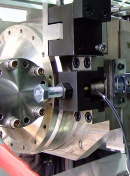Image of the week
IceCube neutrino detector completedOn 19 December, at the height of the antarctic summer, the IceCube neutrino detector was completed after a decade of planning, building, testing and melting holes into ice. The main IceCube detector, a massive ice-bound telescope that fills a cubic kilometre of deep Antarctic ice, now contains 5,160 optical sensors on 86 strings embedded two kilometres below the National Science Foundation’s Amundsen-Scott South Pole Station. |
In the News
- From Nature News 31 December 2010 New year, new science That damned elusive Higgs. Although it is unlikely that the Higgs boson will be spotted this year by the Large Hadron Collider near Geneva, Switzerland, there’s a good chance the collider will turn up something, such as evidence for supersymmetry…
- From physorg.com 24 December 2010 Super-B accelerator funded by Italian government Last week the LHC passed the threshold of 3 pb-1 total integrated luminosity delivered to the experiments, of which about half was delivered in just one week.
- From Daily Mail 23 December 2010 Incredible IceCube observatory built 8,000ft BENEATH the Antarctic ice designed to catch mysterious particles from space Deep beneath the ice of Antarctica, the world’s strangest observatory has finally reached completion.
- From Physics Today 30 December 2010 No microscopic black holes yet From among 1013 proton-proton collisions at 7 GeV in its first year of operation, the Large Hadron Collider (LHC) at CERN has as yet yielded no evidence of black hole production.
- From Science 17 December 2010 NSF Won’t Build Underground Lab; Scientists Hope That DOE Will Plans to convert an abandoned gold mine in South Dakota into the world’s largest underground lab may have to be scaled back and could fall apart entirely after the National Science Foundation’s (NSF’s) oversight board rejected the current proposal.
Copyright © 2025 ILC International Development Team




